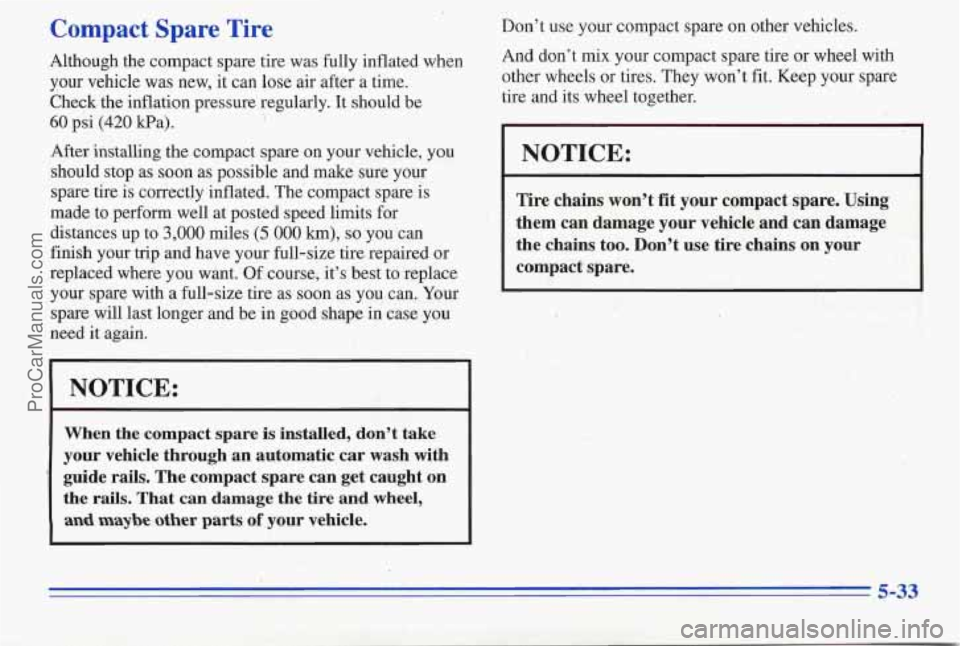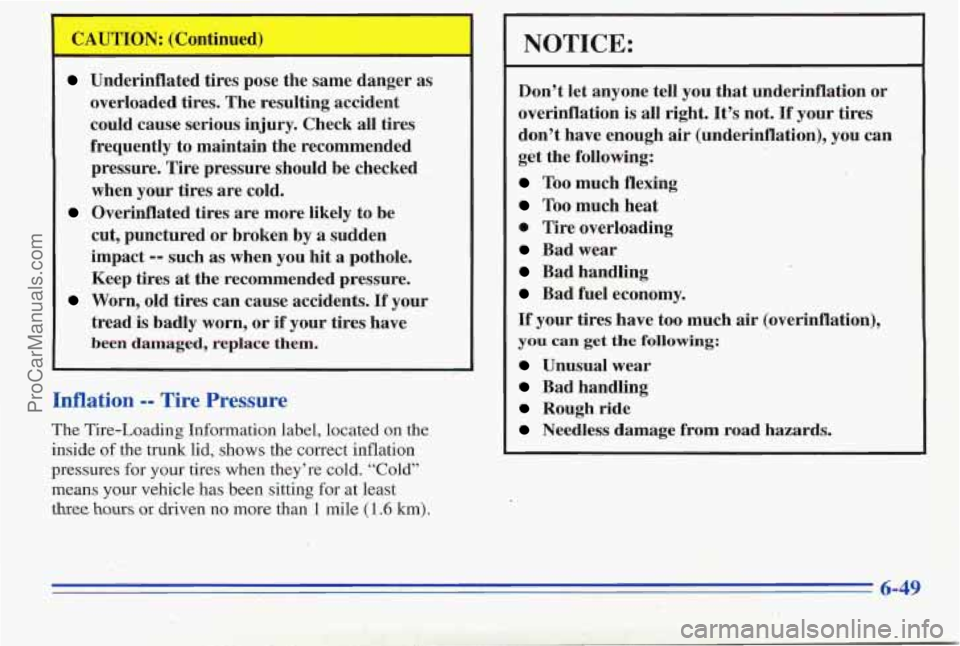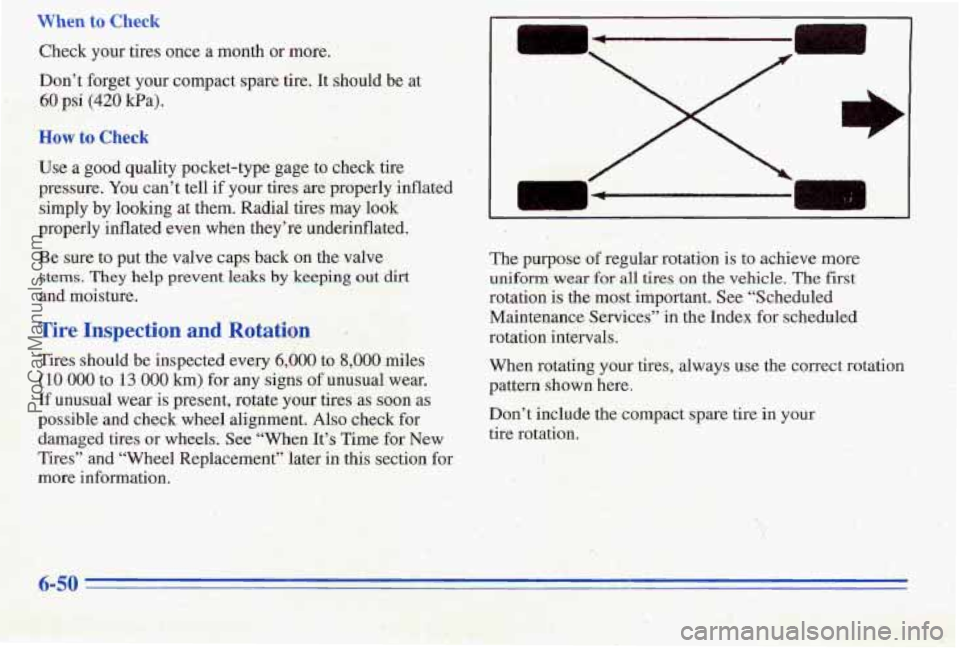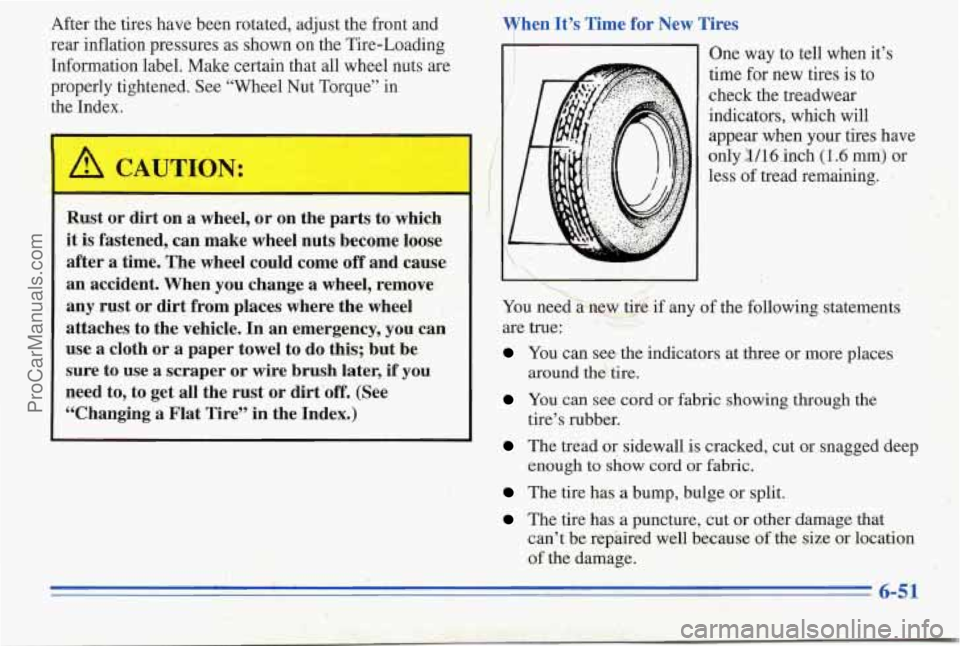Page 221 of 370
4. Raise the vehicle by turning the jack handle
clockwise. Raise the vehicle far enough
off the
ground
for the spare tire to fit under the vehicle.
5. Remove all wheel nuts and take off the flat tire.
6. Remove any rust or dirt
from the wheel bolts,
mounting surfaces and
spare wheel.
A CAUTION:
3'LO -
Rust or dirt on the wheel, or on the parts to
which it is fastened, can make the wheel nuts
become loose
after a time. The wheel could come
off and cause
an accident. When you change a
wheel, remove any rnst
or dirt from the places
where the wheel attaches to
the vehicle. In an
emergency, you can use a cloth or a paper towel
to do this; but be sure to use a scraper or wire
brush later, if
you need to, to get all the rust or
dirt off.
ProCarManuals.com
Page 223 of 370
9. Tighten the wheel nuts
firmly in a crisscross
sequence
as shown.
Incorrect wheel nuts or improperly tightened
'
wheel nuts can cause the wheel to become loose
and even come
off. This could lead to an accident.
Be sure
to use the correct wheel nuts. If you have
to replace them, be sure to get new
GM original
equipment wheel nuts.
Stop somewhere as soon as,you can and have
the nuts tightened with
a torque wrench to
100 lb-ft (140'N.m).
NOTICE:
Improperly tightened wheel nuts can lead to
brake pulsation and rotor damage. To avoid
expensive brake repairs, evenly tighten the wheel
nuts in the proper sequence and
to the proper
torque specification.
Don't
try to put the wheel cover on your compact spare
tire.
It won't fit. Store the wheel cover in the trunk until
you have the flat tire repaired or replaced.
I NOTICE:
Wheel covers won't fit on your compact spare. If
you try to put a wheel cover on your compact
spare,
you could damage the cover or the spare.
ProCarManuals.com
Page 224 of 370
Storing the Flat Tire and Tools
Storing a jack, a tire or other equipment in the passenger compartment
of the vehicle could
cause injury.
In a sudden stop or collision, loose
equipment could strike someone. Store all these
in the proper place.
After you’ve put the compact spare tire on your vehicle,
you’ll need to store the flat tire in your trunk. Use the
following procedure to secure the flat tire in the trunk.
Put the flat tire in the trunk so the side that faces out
when it is on the vehicle is facing down. The full-size
tire will not fit down into the well. Place it
so the front is
in the well and the rear is out
of the well.
I
Put the bolt through one of the wheel nut holes, install
the retainer over the bolt, then install the wing nut. Put
the spacer and nut next to the tire in the well. Store the
cover as far forward as possible.
5-31
ProCarManuals.com
Page 226 of 370

Compact Spare Tire
Although the compact spare tire was fully inflated when
your vehicle was new, it can lose air after a time.
Check, the inflation pressure regularly. It should be
60 psi (420 kPa). ’
After installing the compact spare on your vehicle, you
should stop as soon as possible and make sure your
spare tire
is correctly inflated. The compact spare is
made to perform well at posted speed limits for
distances up to
3,000 miles (5 000 km), so you can
finish your trip and have your full-size
tire repaired or
replaced where you want.
Of course, it’s best to replace
your spare with
a full-size tire as soon as you can. Your
spare will last longer and be in good shape in case you
need
it again.
NOTICE:
When the compact spare is installed, don’t take
your vehicle through an automatic car wash with
’ guide rails. The compact spare can get caught on
the rails. That can damage the
tire and wheel,
and maybe other parts of your vehicle.
Don’t use your compact spare on other vehicles.
And don’t mix your compact spare tire or wheel with
other wheels or tires. They won’t fit. Keep your spare
tire and its wheel together.
NOTICE:
Tire chains won’t fit your compact spare. Using
them can damage your vehicle.and can damage
the chains
too. Don’t use tire chains on your
compact spare.
5-33
ProCarManuals.com
Page 263 of 370
If your vehicle is damaged in an accident and the
headlarnp aim seems to be affected, see your
Pontiac dealer. Headlamps on damaged vehicles
may require recalibration of the horizontal aim by
your Pontiac dealer.
To check the aim, the vehicle should be properly
prepared as follows:
The vehicle must have all four tires an a perfectly
level surface.
0 The vehicle should not have any snow, ice or mud
There should not be my cmgu ur loading of the
attached to it.
vehicle, except it should have
a full tank of gas and
one person or
160 lbs. (75 kg) on the driver’s seat.
0 Tires should be properly inflated.
t
indicator should
read
“0.”
1 0 The horizontal
-
NOTICE:
To make sure your headlamps are aimed
properly, read all the instructions
before
beginning. Failure to follow these instructions
could cause damage to headlamp parts.
State inspection stations will allow a vertical reading of
plus 0.76 degrees or minus 0.76 degrees from the center
of the bubble.
ProCarManuals.com
Page 276 of 370

Underinflated tires pose the same danger as
overloaded tires. The resulting accident
could cause serious injury. Check all tires
frequently to maintain the recommended
pressure. Tire pressure should be checked
when your tires are cold.
cut, punctured or broken by
a sudden
impact
-- such as when you hit a pothole.
Keep tires at the recommended pressure.
Worn, old tires can cause accidents. If your
tread is badly worn, or
if your tires have
been damaged, replace them.
Overinflated tires are more likely to be
InflatiIn -- Tire Pressure
The Tire-Loading rnrormation label, located on the
inside of the trunk lid, shows the correct inflation
pressures
for your tires when they’re cold. “Cold”
means your vehicle has been sitting for at least
three hours or driven no more than 1 mile (1.6 km).
NOTICE:
Don’t let anyone tell you that underinflation or
overinflation is all right.
It’s not. If your tires
don’t have enough air (underinflation), you can
get the following:
Too much flexing
Too much heat
0 Tire overloading
Bad wear
Bad handling
Bad fuel economy.
If your tires have too much air (overinflation),
you can get the following:
Unusual wear
Bad handling
Rough ride
Needless damage from road hazards.
6-49
ProCarManuals.com
Page 277 of 370

When to Check.
Check your tires once a month or more. ~
Don? forget your compact spare tire. It should be at
60 psi (420 @a).
How to Check
Use a good quality pocket-type gage to check tire
pressure.
You can’t tell if your tires awproperly inflated
simply
by looking at them. Radial tires may look
properly inflated even when they’re underinflated.
Be sure to put the valve caps back on the valve
stems. They help prevent leaks by keeping out dirt
and moisture.
Tire Inspection and Rotation I
Tires should be inspected every 6,000 to 8,000 miles
(1.0 000 to 13 000 Ian) for any signs of unusual wear.
If unusual wear is present, rotate your tires as soon as
pos-sible and check wheel alignment.
Also check for
damaged tires or wheels. See “When It’s Time for
New
Tires” and “Wheel Replacement” later in this section for
more information. The
purpose
of regular rotation is to achieve more
uniform wear for all tires on the vehicle. The first
rotation
is the most important. See “Scheduled
Maintenance Services” in the Index for scheduled
rotation intervals.
When rotating your tires, always use the correct rotation
pattern shown here.
. ,. ...
Don’t include the compact spare tire in your
tire rotation.
.L ., !. . ’ I I. .( ’ ’
6-50
ProCarManuals.com
Page 278 of 370

After the tires have been rotated, adjust the front and
rear inflation pressures as shown on the Tire-Loading
Information label. Make certain that all wheel nuts are
properly tightened. See “Wheel Nut Torque” in
the Index.
Rust or dirt on a wheel, or on the parts to-which
it is fastened, can make wheel nuts become loose
after a time. The wheel could come
off and cause
an accident. When you change a wheel, remove
any rust or dirt from places where the wheel
attaches to the vehicle. In an emergency, you can
use a cloth or
a paper towel to do this; but be
sure to use a scraper or wire brush later,
if you
need to, to get all the rust or dirt ‘off. (See
“Changing a Flat Tire” in the Index.)
/ I
I 1 I
Then It’s Time for New Tires
One way to tell when it’s
time for new tires is to
check the treadwear
indicators, which will
appear when your tires have
only
11/16 inch (I .6 mm) or
less of tread remaining.
ll.
You needknwt.re if any of the following statements
are true:
You can see. the indicators at three or more places
You can see cord or fabric showing through the
The tread or sidewall is cracked, cut or snagged deep
~~
around the tire.
tire’s rubber.
6,’ . 1. ‘ 1 enough to show cord or fabric. -. . . ..
;C I ., The tire has a bump, bulge or split.
-1 P. The tire has a puncture, cut or other damage that
can’t be repaired well because
of the size or location
of the damage.
6-51
ProCarManuals.com